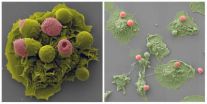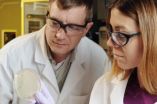(Press-News.org) Munich, Germany: The temperature of exhaled breath could be used to diagnose lung cancer, according to a new study.
The research, presented at the European Respiratory Society (ERS) International Congress in Munich today (8 September 2013), suggests that testing the temperature of breath could be a simple and noninvasive method to either confirm or reject the presence of lung cancer.
Many research teams have been looking at the possibility of using breath tests for a number of cancers. This is the first study looking at breath temperature as a marker in lung cancer.
The researchers enrolled 82 people in the study who had been referred for a full diagnostic test after an x-ray suggested the presence of lung cancer. 40 patients received a positive diagnosis, while 42 patients had the diagnosis rejected. Researchers measured the temperature of exhaled breath in all patients using a breath thermometer device, known as an X-Halo device.
The results demonstrated that the patients with lung cancer had a higher breath temperature than those without. The temperature also increased with the number of years a person had smoked and the stage at which their lung cancer had developed.
The researchers also identified a cut-off value in the measurement of temperature, which they proved could identify lung cancer with a high level of accuracy.
Professor Giovanna Elisiana Carpagnano, lead author of the study from the University of Foggia, Italy, said: "Our results suggest that lung cancer causes an increase in the exhaled temperature. This is a significant finding and could change the way we currently diagnose the disease. If we are able to refine a test to diagnose lung cancer by measuring breath temperature, we will improve the diagnostic process by providing patients with a stress-free and simple test that is also cheaper and less intensive for clinicians."
INFORMATION: END
Breath temperature test could identify lung cancer
2014-09-08
ELSE PRESS RELEASES FROM THIS DATE:
Many patients in cancer centers may not experience a dignified death
2014-09-08
A new study that surveyed physicians and nurses in hospitals within cancer centers in Germany suggests that many patients there do not experience a dignified death. Published early online in Cancer, a peer-reviewed journal of the American Cancer Society, the study indicates the need for cancer centers to invest more in palliative care services, adequate rooms for dying patients, staff training in end-of-life care, and advance-care-planning standards.
Previous research has shown that hospitals are often ill-prepared to provide care for dying patients. To investigate whether ...
Global food trade may not meet all future demand, University of Virginia study indicates
2014-09-08
As the world population continues to grow, by about 1 billion people every 12 to 14 years since the 1960s, the global food supply may not meet escalating demand – particularly for agriculturally poor countries in arid to semi-arid regions, such as Africa's Sahel, that already depend on imports for much of their food supply.
A new University of Virginia study, published online in the American Geophysical Union journal, Earth's Future, examines global food security and the patterns of food trade that – until this analysis – have been minimally studied.
Using production ...
Taking short walking breaks found to reverse negative effects of prolonged sitting
2014-09-08
BLOOMINGTON, Ind. -- An Indiana University study has found that three easy -- one could even say slow -- 5-minute walks can reverse harm caused to leg arteries during three hours of prolonged sitting.
Sitting for long periods of time, like many people do daily at their jobs, is associated with risk factors such as higher cholesterol levels and greater waist circumference that can lead to cardiovascular and metabolic disease. When people sit, slack muscles do not contract to effectively pump blood to the heart. Blood can pool in the legs and affect the endothelial ...
Sleeping on animal fur in infancy found to reduce risk of asthma
2014-09-08
Munich, Germany: Sleeping on animal fur in the first three months of life might reduce the risk of asthma in later childhood a new study has found.
The new research, presented at the European Respiratory Society (ERS) International Congress in Munich today (8 September 2014), suggests that exposure to the microbial environment in animal skin and fur could have a protective effect against asthma and allergies.
Previous studies have suggested that exposure to a wider range of environments fromyoung age could be protective against asthma and allergies. These findings ...
The Lancet HIV: High rates of recreational drug use among HIV-positive gay and bisexual men in the UK strongly linked with condomless sex
2014-09-08
New research published in The Lancet HIV shows that polydrug use is common among HIV-positive men who have sex with men (MSM) [1] and is strongly linked to sex without a condom (condomless sex).
This is the largest questionnaire study of people living with HIV in the UK, accounting for about 5% of all HIV-diagnosed MSM in the UK. The findings show that half of MSM surveyed had used recreational drugs at least once in the previous 3 months [2]. About half of those who used drugs took three or more different types of drugs, while roughly a fifth said they had used five ...
The Lancet Respiratory Medicine: Benralizumab for chronic obstructive pulmonary disease and sputum eosinophilia
2014-09-08
Chronic obstructive pulmonary disease (COPD) is associated with eosinophilic airway inflammation in 10–20% of patients. Benralizumab, a monoclonal antibody, has been shown to decrease the number of blood and sputum eosinophils. In this trial of 101 patients with COPD whether benralizumab reduces the number of acute exacerbations was investigated. Benralizumab was found to be no more effective at preventing acute COPD exacerbations than placebo overall. However, the authors conclude that subgroup analyses suggest more research into the use of benralizumab in patients with ...
Dynamic duo takes out the cellular trash
2014-09-07
LA JOLLA—In most of the tissues of the body, specialized immune cells are entrusted with the task of engulfing the billions of dead cells that are generated every day. When these garbage disposals don't do their job, dead cells and their waste products rapidly pile up, destroying healthy tissue and leading to autoimmune diseases such as lupus and rheumatoid arthritis.
Now, Salk scientists have discovered how two critical receptors on these garbage-eating cells identify and engulf dead cells in very different environments, as detailed today in Nature Immunology.
"To ...
Platelet-like particles augment natural blood clotting for treating trauma
2014-09-07
A new class of synthetic platelet-like particles could augment natural blood clotting for the emergency treatment of traumatic injuries – and potentially offer doctors a new option for curbing surgical bleeding and addressing certain blood clotting disorders without the need for transfusions of natural platelets.
The clotting particles, which are based on soft and deformable hydrogel materials, are triggered by the same factor that initiates the body's own clotting processes. Testing done in animal models and in a simulated circulatory system suggest that the particles ...
Why age reduces our stem cells' ability to repair muscle
2014-09-07
Ottawa, Canada (September 7, 2014) — As we age, stem cells throughout our bodies gradually lose their capacity to repair damage, even from normal wear and tear. Researchers from the Ottawa Hospital Research Institute and University of Ottawa have discovered the reason why this decline occurs in our skeletal muscle. Their findings were published online today in the influential journal Nature Medicine.
A team led by Dr. Michael Rudnicki, senior scientist at the Ottawa Hospital Research Institute and professor of medicine at the University of Ottawa, found that as muscle ...
Rethinking the basic science of graphene synthesis
2014-09-07
A new route to making graphene has been discovered that could make the 21st century's wonder material easier to ramp up to industrial scale. Graphene -- a tightly bound single layer of carbon atoms with super strength and the ability to conduct heat and electricity better than any other known material -- has potential industrial uses that include flexible electronic displays, high-speed computing, stronger wind-turbine blades, and more-efficient solar cells, to name just a few under development.
In the decade since Nobel laureates Konstantin Novoselov and Andre Geim proved ...


